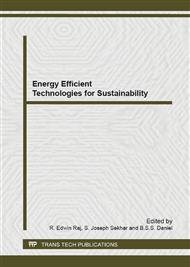[1]
Hansen AC, Lyne PWL. Ethanol-diesel blends: a step towards a bio-based fuel for diesel engines. ASAE paper 01e6048; (2001).
DOI: 10.13031/2013.3586
Google Scholar
[2]
Li D, Zhen H, Xing-cai L, Wu-gao Z, Jian-guang Y. Physico-chemical properties of ethanol-diesel blend fuel and its effect on performance and emissions of diesel engines. Renew Energ 2005; 30: 967e76.
DOI: 10.1016/j.renene.2004.07.010
Google Scholar
[3]
Hansen AC, Zhang Q, Lyne PWL. Ethanol-diesel fuel blends e a review. Bioresour Technol 2005; 96: 277e85.
Google Scholar
[4]
Waterland LR, Venkatesh S, Unnasch S. Safety and performance of ethanol/ diesel blends (E-diesel). NREL subcontractor report; 2003. NREL/SR- 540e34817.
DOI: 10.2172/15004720
Google Scholar
[5]
Kwanchareon P, Luengnarunumitchai A, Jai- S. Solubility of a diesel-biodieselethanol blends, its fuel properties, and its emission characteristics from diesel engine. Fuel 2007; 86: 1053e61.
DOI: 10.1016/j.fuel.2006.09.034
Google Scholar
[6]
Lu X, Huang Z, Zhang W, Li D. Combustion visualization and emissions of a direct injection compression ignition engine fueled with bio-diesohol. Int J Auto Tech-Kor 2005; 6: 15–21.
Google Scholar
[7]
Yan Y, Zhang Y, Rao S, Zhang R, Wu D. Study of combustion and emission characteristics of diesel engines fueled with ethanol/diesel blended fuel. SAE tech paper; 2009. SAE 2009-01-2675.
DOI: 10.4271/2009-01-2675
Google Scholar
[8]
Xu BY, Qi YL, Zhang WB, Cai SL. Fuel properties and emissions characteristics of ethanol–diesel blend on small diesel engine. Int J Auto Tech-Kor 2007; 8: 9–18.
Google Scholar
[9]
Sahin Z, Durgun O. Prediction of the effects of ethanol–diesel fuel blends on diesel engine performance characteristics, combustion, exhaust emissions, and cost. Energy Fuel 2009; 23: 1707–17.
DOI: 10.1021/ef800587e
Google Scholar
[10]
Mohammadi A, Kee S, Ishiyama T, Kakuta T, Matsumoto T. Implementation of ethanol diesel blend fuels in PCCI combustion. SAE tech paper; 2005. SAE 2005-01-3712.
DOI: 10.4271/2005-01-3712
Google Scholar
[11]
Opat R, Ra Y, Gonzalez MA, Krieger R, Reitz RD, Foster DE, et al. Investigation of mixing and temperature effects on HC/CO emissions for highly dilute low temperature combustion in a light duty diesel engine. SAE tech paper; 2007. SAE 2007-01-0193.
DOI: 10.4271/2007-01-0193
Google Scholar
[12]
Bobba MK, Musculus MPB. Laser diagnostics of soot precursors in a heavy-duty diesel engine at low-temperature combustion conditions. Combust Flame 2012; 159: 832–43.
DOI: 10.1016/j.combustflame.2011.07.017
Google Scholar
[13]
Jacobs TJ, Assanis DN. The attainment of premixed compression ignition lowtemperature combustion in a compression ignition direct injection engine. P Combust Inst 2007; 31: 2913–20.
DOI: 10.1016/j.proci.2006.08.113
Google Scholar
[14]
Kim DS, Kim MY, Lee CS. Combustion and emission characteristics of partial homogeneous charge compression ignition engine. Combust Sci Technol 2005; 177: 107–25.
DOI: 10.1080/00102200590883778
Google Scholar
[15]
Asad U, Zheng M, Han X, Reader GT, Wang M. Fuel injection strategies to improve emissions and efficiency of high compression ratio diesel engines. SAE tech paper; 2008. SAE 2008-01-2472.
DOI: 10.4271/2008-01-2472
Google Scholar
[16]
Mosbach S, Su H, Kraft M, Bhave A, Mauss F, Wang Z, et al. Dual injection homogeneous charge compression ignition engine simulation using a stochastic reactor model. Int J Engine Res 2007; 8: 41–50.
DOI: 10.1243/14680874jer01806
Google Scholar
[17]
Kim MY, Lee JH, Lee CS. Combustion characteristics and NOx emissions of a dimethyl-ether-fueled premixed charge compression ignition engine. Energy Fuel 2008; 22: 4206–12.
DOI: 10.1021/ef800221g
Google Scholar
[18]
Mancaruso E, Vaglieco BM. Premixed combustion of GTL and RME fuels in a single cylinder research engine. Appl Energy 2012; 91: 385–94.
DOI: 10.1016/j.apenergy.2011.10.010
Google Scholar
[19]
Yoon SH, Lee CS. Experimental investigation on the combustion and exhaust emission characteristics of biogas–biodiesel dual-fuel combustion in a CI engine. Fuel Process Technol 2011; 92: 992–1000.
DOI: 10.1016/j.fuproc.2010.12.021
Google Scholar
[20]
Szybist JP, Song J, Alam M, Boehman AL. Biodiesel combustion, emissions and emission control. Fuel Process Technol 2007; 88: 679–91.
DOI: 10.1016/j.fuproc.2006.12.008
Google Scholar
[21]
Ishida M, Yamamoto S, Ueki H, Sakaguchi D. Remarkable improvement of NOx- PM trade-off in a diesel engine by means of biodiesel and EGR. Energy 2010; 35: 4572–81.
DOI: 10.1016/j.energy.2010.03.039
Google Scholar
[22]
Brunt FJ, Hai H, Emtage A. The calculation of heat release energy from engine cylinder pressure data. SAE Paper No. 981052; (1998).
DOI: 10.4271/981052
Google Scholar
[23]
Holman J.P. Experimental techniques for engineers. New Delhi: Tata McGraw- Hill Publishing Company Limited; (2004).
Google Scholar


